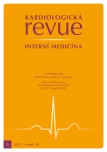Cardiovascular risk stratification and new serum lipid target levels
Authors:
E. Tůmová; M. Vráblík
Authors‘ workplace:
Centrum preventivní kardiologie, III. interní klinika – klinika endokrinologie a metabolismu 1. LF UK a VFN v Praze
Published in:
Kardiol Rev Int Med 2017, 19(3): 152-156
Overview
Cardiovascular diseases are the leading cause of morbidity and mortality in developed countries and their prevention is one of the cornerstones of today’s preventive medicine. Preventive strategy is based on healthy lifestyle changes and, if required, medication addressing the particular risk factors. Individual cardiovascular risk assessment in each patient must form an integral part of the therapeutic considerations, as it will point towards suitable therapeutic measures aimed at achieving a specific therapeutic target.
Key words:
cardiovascular diseases – risk factors – SCORE – LDL-cholesterol
Sources
1. Conroy RM, Pyorala K, Fitzgerald AP et al. Estimation of ten-year risk of fatal cardiovascular disease in Europe: the SCORE project. Eur Heart J 2003; 24(11): 987 – 1003.
2. Cooney MT, Dudina AL, Graham IM. Value and limitations of existing scores for the assessment of cardiovascular risk: a review for clinicians. J Am Coll Cardiol 2009; 54(14): 1209 – 1227. doi: 10.1016/ j.jacc.2009.07.020.
3. Cooney MT, Dudina A, D'Agostino R et al. Cardiovascular risk estimation systems in primary prevention: do Theky differ? Do they make a difference? Can we see the future? Circulation 2010; 122(3): 300 – 310. doi: 10.1161/ CIRCULATIONAHA.109.852756.
4. Lloyd-Jones DM, Leip EP, Larson MG et al. Prediction of lifetime risk for cardiovascular disease by risk factor burden at 50 years of age. Circulation 2006; 113(6): 791 – 798. doi: 10.1161/ CIRCULATIONAHA.105.548206
5. Mortensen MB, Afzal S, Nordestgaard BG et al. The high-density lipoprotein-adjusted SCORE model worsens SCORE-based risk classification in a contemporary population of 30,824 Europeans: the Copenhagen General Population Study. Eur Heart J 2015; 36(36): 2446 – 2453. doi: 10.1093/ eurheartj/ ehv251.
6. Boekholdt SM, Hovingh GK, Mora S. Very low levels of atherogenic lipoproteins and the risk for cardiovascular events: a meta-analysis of statin trials. J Am Coll Cardiol 2014; 64(5): 485 – 494. doi: 10.1016/ j.jacc.2014.02.615.
7. Brugts JJ, Yetgin T, Hoeks SE et al. The benefits of statins in people without established cardiovascular disease but with cardiovascular risk factors: meta-analysis of randomised controlled trials. BMJ 2009; 338: b2376. doi: 10.1136/ bmj.b2376.
8. Cannon CP, Blazing MA, Giugliano RP. Ezetimibe added to statin therapy after acute coronary syndromes. N Engl J Med 2015; 372(25): 2387 – 2397. doi: 10.1056/ NEJMoa1410489.
9. Baigent C, Blackwell L, Emberson J et al. Cholesterol Treatment Trialists' (CTT) Collaboration. Efficacy and safety of more intensive lowering of LDL cholesterol: a meta-analysis of data from 170,000 participants in 26 randomised trials. Lancet 2010; 376(9753): 1670 – 1681. doi: 10.1016/ S0140-6736(10)61350-5.
10. Fulcher J, O'Connell R, Voysey M et al. Cholesterol Treatment Trialists' (CTT) Collaboration. Efficacy and safety of LDL-lowering therapy among men and women: meta-analysis of individual data from 174,000 participants in 27 randomised trials. Lancet 2015; 385(9976): 1397 – 1405. doi: 10.1016/ S0140-6736(14)61368-4.
11. Mihaylova B, Emberson J, Blackwell L et al. Cholesterol Treatment Trialists' (CTT) Collaborators. The effects of lowering LDL cholesterol with statin therapy in people at low risk of vascular disease: meta-analysis of individual data from 27 randomised trials. Lancet 2012; 380(9841): 581 – 590. doi: 10.1016/ S0140-6736(12)60367-5.
12. Hegele RA, Ginsberg HN, Chapman MJ et al. The polygenic nature of hypertriglyceridaemia: implications for definition, diagnosis, and management. Lancet Diabetes Endocrinol 2014; 2(8): 655 – 666. doi: 10.1016/ S2213-8587(13)70191-8.
13. Mills EJ, Rachlis B, Wu P et al. Primary preventive of cardiovascular mortality and events with statin treatments: a network meta-analysis involving more than 65,000 patients. J Am Coll Cardiol 2008; 52(22): 1769 – 1781. doi: 10.1016/ j.jacc.2008.08.039.
14. Pedersen TR, Faergeman O, Kastelein JJ et al. High-dose atorvastatin vs usual-dose simvastatin for secondary prevention after myocardial infarction: the IDEAL study: a randomized controlled trial. JAMA 2005; 294(19): 2437 – 2445.
15. Wright JT Jr., Williamson JD, Whelton PK et al. SPRINT Research Group. A randomized trial of intensit versus standard blood-pressure control. N Engl J Med 2015; 373(22): 2103 – 2116. doi: 10.1056/ NEJMoa1511939.
16. Stone NJ, Robinson JG, Lichtenstein AH et al. 2013 ACC/ AHA guideline on the treatment of blood cholesterol to reduce atherosclerotic cardiovascular risk in adults: a report of the American College of Cardiology/ American Heart Association Task Force on Practice Guidelines. Circulation 2014; 129 (25 Suppl 2):S1 – S45. doi: 10.1161/ 01.cir.0000437738.63853.7a.
17. Fulcher J, O'Connell R, Voysey M et al. Cholesterol Treatment Trialists' (CTT) Collaboration. Efficacy and safety of LDL-lowering therapy among men and women: meta-analysis of individual data from 174,000 participants in 27 randomised trials. Lancet 2015; 385(9976): 1397 – 1405. doi: 10.1016/ S0140-6736(14)61368-4.
18. Hsia J, MacFadyen JG, Monyak J et al. Cardiovascular event reduction and adverse events among subjects attaining low-density lipoprotein cholesterol < 50 mg/ dl with rosuvastatin. The JUPITER trial (Justification for the Use of Statins in Prevention: an Intervention Trial Evaluating Rosuvastatin). J Am Coll Cardiol 2011; 57(16): 1666 – 1675. doi: 10.1016/ j.jacc.2010.09.082.
Labels
Paediatric cardiology Internal medicine Cardiac surgery CardiologyArticle was published in
Cardiology Review

2017 Issue 3
Most read in this issue
- SGLT2 inhibitors (gliflozins) antidiabetics, antihypertensives or drugs for heart failure?
- Cardiovascular risk stratification and new serum lipid target levels
- Statin intolerance – finding practical solutions
- Infective Endocarditis
